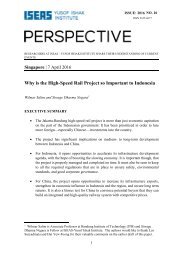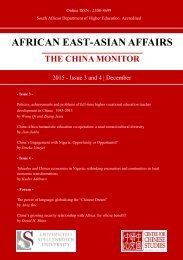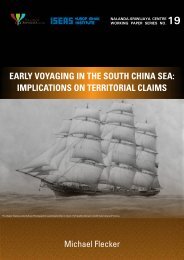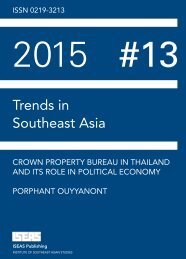Create successful ePaper yourself
Turn your PDF publications into a flip-book with our unique Google optimized e-Paper software.
Two days after <strong>the</strong> Japanese <strong>in</strong>v<strong>as</strong>ion of Malaya on 10 December 1941, <strong>the</strong> MCP declared<br />
arm<strong>in</strong>g <strong>the</strong>mselves to protect Malaya aga<strong>in</strong>st Japan and soon afterwards organized <strong>the</strong> <strong>Malayan</strong><br />
People’s Anti-Japanese Army. 8 When <strong>the</strong> War ended, <strong>the</strong> MCP decided not to wage an armed<br />
struggle aga<strong>in</strong>st <strong>the</strong> return<strong>in</strong>g British Imperialist. In early 1948, ow<strong>in</strong>g to severe suppression by <strong>the</strong><br />
colonial authorities, <strong>the</strong> MCP decided to commence armed struggle. In <strong>the</strong> mid-1950s, <strong>the</strong> MCP<br />
adopted peaceful negotiation l<strong>in</strong>e which culm<strong>in</strong>ated <strong>in</strong> <strong>the</strong> Bal<strong>in</strong>g Peace Talks. But <strong>in</strong> September<br />
1961, <strong>the</strong> MCP decided to re-start armed struggle. This decision w<strong>as</strong> implemented <strong>in</strong> June 1968 and<br />
<strong>the</strong> armed struggle l<strong>as</strong>ted until <strong>the</strong> Hadyai Peace Treaty of December 1989. 9<br />
It can be discerned that <strong>the</strong> political l<strong>in</strong>es of <strong>the</strong> MCP were comparatively moderate before<br />
<strong>the</strong> Pacific War. It had no tradition of, no <strong>in</strong>cl<strong>in</strong>ation to, an armed struggle dur<strong>in</strong>g this period. It<br />
w<strong>as</strong> not until 1948, when <strong>the</strong> MCP felt <strong>the</strong> colonial authorities were too stubborn, too oppressive to<br />
negotiate, that <strong>the</strong> <strong>Party</strong> resorted to an armed struggle.<br />
12. <strong>The</strong> fact that <strong>the</strong> Com<strong>in</strong>tern did not send <strong>in</strong>structions to <strong>the</strong> MCP after 1936 might lead us to<br />
an <strong>as</strong>sumption that <strong>the</strong> decisions and <strong>the</strong>ir changes were <strong>the</strong> result of <strong>in</strong>ternal analyses, review,<br />
probation and effort.<br />
Though <strong>the</strong> MCP, abid<strong>in</strong>g by Com<strong>in</strong>tern’s ce<strong>as</strong>eless <strong>in</strong>structions, made with all its might an<br />
effort to organize “red” trade unions especially <strong>in</strong> such important <strong>in</strong>dustries <strong>as</strong> rubber plantations,<br />
m<strong>in</strong>es and transportation, it w<strong>as</strong> difficult to bear satisfactory fruits for long. Expansion of <strong>Party</strong><br />
membership <strong>as</strong> well <strong>as</strong> <strong>in</strong>fluence were also not so smooth while <strong>the</strong> MCP w<strong>as</strong> receiv<strong>in</strong>g <strong>in</strong>structions<br />
from <strong>the</strong> Com<strong>in</strong>tern. But its movement ga<strong>in</strong>ed momentum dur<strong>in</strong>g 1935 and 1936. In 1937, <strong>the</strong><br />
MCP succeeded <strong>in</strong> mobiliz<strong>in</strong>g several thousand m<strong>in</strong><strong>in</strong>g workers of Batu Arang Colliery, Selangor,<br />
to strike. At <strong>the</strong> 2nd Plenum of <strong>the</strong> MCP <strong>in</strong> 1940, it w<strong>as</strong> reported that membership of <strong>the</strong> <strong>Party</strong> <strong>as</strong><br />
well <strong>as</strong> <strong>the</strong> affiliated organizations were more than doubled and that 80,000 workers participated <strong>in</strong><br />
<strong>the</strong> <strong>Party</strong>-led struggles. <strong>The</strong>se might be attributed to <strong>the</strong> MCP’s own effort, not to <strong>the</strong> Com<strong>in</strong>tern<br />
<strong>in</strong>struction.<br />
13. Dur<strong>in</strong>g <strong>the</strong> short period immediately follow<strong>in</strong>g <strong>the</strong> outbreak of <strong>the</strong> S<strong>in</strong>o-Japanese war, <strong>the</strong><br />
MCP’s political l<strong>in</strong>e or viewpo<strong>in</strong>t oscillated between radicalism and moderation. Yet even <strong>the</strong><br />
policy change <strong>the</strong>n could not be attributed to changes <strong>in</strong> <strong>the</strong> <strong>in</strong>ternational or local political<br />
situations only. It w<strong>as</strong> quite possible, too, that <strong>the</strong> MCP adopted a moderate l<strong>in</strong>e when Lai Teck<br />
managed to <strong>in</strong>fluence or persuade its CSC or CEC. <strong>The</strong> <strong>Party</strong> adopted <strong>the</strong> radical l<strong>in</strong>e, however,<br />
134








